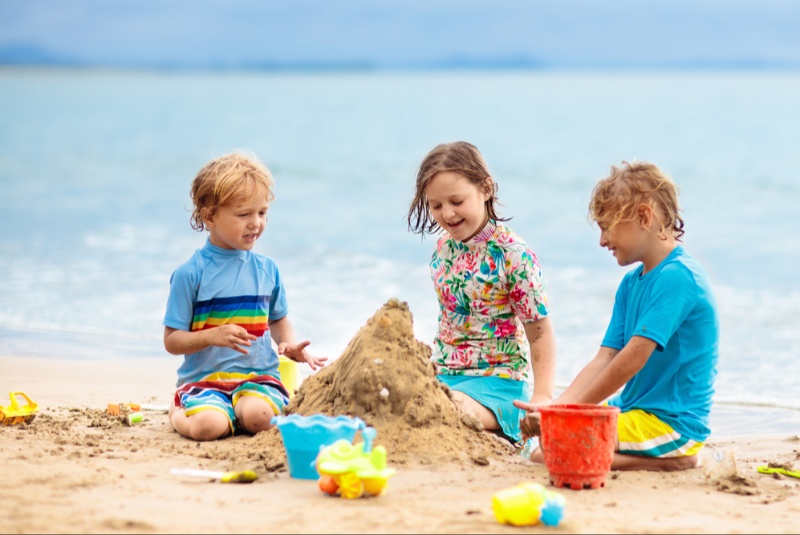As summer rolls around, parents and caregivers look forward to spending delightful days at the beach with their children. Equipping kids with the right beach toys can transform a simple beach day into an extraordinary adventure. This guide provides detailed insights to help you choose beach toys that are safe, fun, and suitable for children of all ages, enhancing their beach experience and encouraging outdoor play.
Understanding Age Appropriateness
Selecting age-appropriate toys is crucial for the safety and enjoyment of children. For toddlers, toys should be large enough to avoid choking hazards and easy to handle. Items like large shovels, bucket sets, and playful, oversized beach balls are ideal. Preschoolers might enjoy slightly more complex toys that stimulate creativity and coordination, such as detailed sand molds and beginner water guns. Older children and teenagers would appreciate more active toys, including boogie boards, kites, and beach volleyball sets. Always consider the manufacturer's age recommendations to ensure the toys are suitable for your child's developmental stage.
Prioritizing Safety and Durability
Safety is paramount when choosing beach toys. Ensure that the toys are made from non-toxic materials and do not have sharp edges or small, detachable parts that could pose risks to younger children. Durability also plays a significant role, as beach toys often endure rough handling and exposure to elements like sand, sun, and salty water. Opt for high-quality, durable materials that can withstand these conditions to ensure the toys last through many beach seasons.
Incorporating Educational Value
Beach time can be more than just fun; it can also be a learning experience. Toys that encourage building and problem-solving, such as complex sandcastle builders or water mills, help children develop fine motor skills and stimulate their imagination. Educational toys that involve nature exploration, such as nets for catching and observing small fish or portable aquarium kits, can spark a child’s interest in marine biology and environmental science.
Choosing Multi-Functional Toys
Multi-functional toys offer excellent value and versatility, allowing for various types of play with a single purchase. For example, a frisbee can be used traditionally in the air or as an impromptu sand sifter or water carrier. Beach balls can be used for volleyball, to float in the water, or even as part of a sandcastle structure. Opting for toys that serve multiple purposes can reduce clutter in your beach bag and keep children engaged in different ways throughout the day.
Ensuring Easy Cleaning and Maintenance
Select toys that are easy to clean and maintain. Sand and saltwater can quickly degrade toys if they're not properly cared for. Look for toys that can be easily rinsed off and dried, without many nooks and crannies where sand can accumulate. Water-resistant materials are ideal as they help prevent mold and mildew from developing and ensure that toys dry quickly after use.

Assessing Portability and Storage
Considering the ease of transportation and storage of beach toys is important, especially if you have to carry them along with other beach essentials. Lightweight and collapsible toys, like silicone buckets or foldable beach mats, are perfect as they take up less space and are easier to carry. Additionally, many beach toys come with mesh bags or carry cases that help keep them organized and make them easy to transport to and from the beach.
Opting for Eco-Friendly Toys
Choosing eco-friendly beach toys is a responsible decision that helps protect the marine environment and promotes sustainability. Look for toys made from recycled materials or natural products that are biodegradable. Eco-friendly toys not only minimize environmental impact but also often offer superior durability and safety, free from harmful chemicals.
Balancing Fun with Engagement
The best beach toys are those that keep children entertained and engaged for hours. Consider toys that can be used in group settings, like beach paddle sets, balls, or even a simple set of racing boats, which encourage interaction and can help children develop social skills while playing. Additionally, toys that can adapt to different play scenarios are likely to hold children's interest longer and stimulate their creativity.
Leveraging Customer Reviews and Smart Shopping Tactics
Before making a purchase, read customer reviews to get an idea of how toys hold up in real-world conditions and how much other children have enjoyed them. Reviews can highlight durability issues or safety concerns and help you make a well-informed decision. Moreover, compare prices across different retailers, look for sales or discounts, and consider the best time to buy beach toys, often during off-season months when they are less in demand.
Considering Aesthetics and Personal Preferences
While functionality and safety are crucial, the visual appeal of toys can also influence their desirability and the enjoyment children get from them. Bright colors and fun designs can make toys more attractive to kids and can even help in their development by stimulating their visual senses. Choose toys that visually appeal to your child and fit the festive, playful mood of summer.
By carefully considering these factors, you can ensure that the beach toys you purchase are not only enjoyable and safe for your children but also offer lasting value. With the right toys, summer days spent by the sea can become cherished memories of fun and learning, making every beach outing a much-anticipated adventure.




